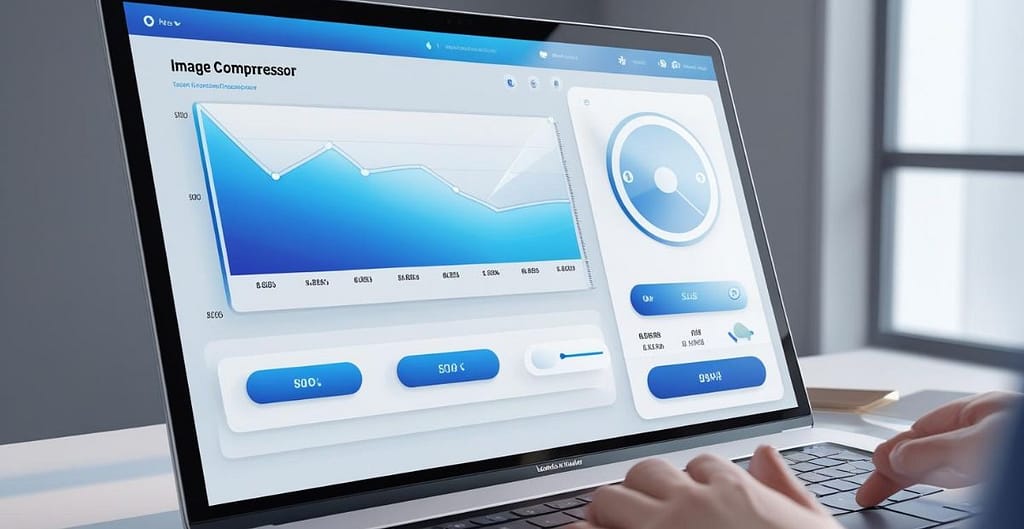
The Image Compressor Tool is the best tool to compress images online. It is designed for website owners, bloggers, and digital marketers. They need fast-loading images without sacrificing quality. This photo compressor reduces image file size. It maintains sharpness. That makes it ideal for compressing images for websites like WordPress, Shopify, or Wix. By using this image optimization tool, you can enhance website performance. You will improve user experience. Additionally, you can boost your SEO image optimization metrics. Whether you’re managing a personal blog or a large e-commerce platform, this online image reducer streamlines your workflow.
This free online picture compressor helps you achieve a balance between image quality and file size. It’s perfect for reducing photo size without losing quality, improving page load speed, and increasing image compression efficiency. The tool supports lossless image compression. It is designed to meet web performance standards. These features make it a top choice for compressing large images quickly. It ensures visuals are optimized for faster website loading.
Tool link: image compressor
What Is Image Compression and Why Does It Matter?
Image compression reduces image size. It shrinks the file size of images by removing unnecessary data. This enables faster loading on websites and apps. It balances file size reduction with image quality retention, often expressed as a percentage of compression. Large image files can slow down page load times, negatively impacting website speed optimization and user engagement metrics. This fast image optimizer ensures your images are optimized for web image compression and content discoverability.
Search engines like Google prioritize fast-loading websites, so a high image compression rate improves your SEO image improvement score. For businesses, compressed images for WordPress, Shopify, or Wix mean lower bandwidth costs and better user retention. If you want to rank higher or keep visitors engaged, use a file size reduction tool like this one. Enhance it with keywords such as “photo size converter” and “picture resizer and compressor.” This is essential.
How the Image Compressor Tool Works
The Image Compressor Tool is a JPEG optimizer and PNG compressor that uses advanced algorithms to compress images efficiently. The tool applies a compression formula.
Compression Rate = (Original File Size – Compressed File Size) ÷ Original File Size × 100
This calculates the file size reduction. It preserves visual quality. The tool supports formats like JPEG, PNG, and WebP, ensuring compatibility for compressing images for websites and other platforms.
Unlike basic tools, this image optimization tool offers customizable settings for lossless image compression or lossy compression, depending on your needs. You can instantly see the file size reduction percentage and compare results with image compression benchmarks. The user-friendly interface ensures ease of use, while optimization aligns with search engine standards, making it ideal for compressing images while maintaining clarity.
How to Use Our Free Image Compressor Tool
Using this free image optimization software is simple. Upload your image by dragging it into the tool or clicking the upload button. Select your desired compression level (e.g., high, medium, or low), and click “Compress.” Within seconds, you’ll get a compressed image with details like the new file size and compression percentage. This is the smallest file size image compressor for reducing photo size for email attachments or web use without manual editing.
For deeper insights, the tool offers a free trial image optimization analytics feature. This lets you compare compression results across multiple images or track performance over time, perfect for bulk image compression tool users. It’s ideal for analyzing image compression trends or comparing results with industry benchmarks, using keywords like “shrink photo online” and “web image compression.”
Average Image Compressor Tool Benchmarks
Different industries have different compression needs. Here’s a table to help you compare:
| Compression Rate Range | Performance Level | Example Use Cases |
|---|---|---|
| 0%–20% | Low | High-quality photography portfolios |
| 20%–50% | Good | Blog images, social media posts |
| 50%–70% | High | E-commerce product images, website banners |
| 70%+ | Exceptional | Thumbnails, email marketing images |
This table shows why image compression benchmarks by industry matter. The average compression rate varies depending on content and platform requirements, ensuring alignment with goals like optimizing images for faster website loading.
How to Track Image Compression Over Time
Tracking your compression results with this tool to shrink pictures for web use helps maintain consistent website performance. For example, a portfolio website might need minimal compression to preserve quality, while an e-commerce site prioritizes high compression for faster load times. Regularly using this photo compressor lets you monitor file size reduction trends and adjust settings based on image compression analytics, especially for platforms like WordPress, Shopify, or Wix.
This data guides decisions like choosing the best image format for SEO or balancing quality and speed for campaigns. It’s also useful for comparing your website’s performance against competitors using keywords like “compress PNG images” and “fast image optimizer.”
Comparing Image Compression Across Platforms
Each platform has unique image requirements. For websites, file size impacts load speed, while social media platforms prioritize specific dimensions and formats. Using tools like a WebP converter, JPEG optimizer, or PNG compressor alongside this image optimization tool helps tailor images for different platforms.
If you manage multiple platforms, comparing compression rates with this bulk image compression tool ensures optimal performance across websites, emails, and social media. This is crucial for businesses using digital asset optimization tools to maintain consistency, supported by queries like “compress images for WordPress” and terms like “picture resizer and compressor.”
Factors That Influence Image Compressor Tool Rates
Several factors affect compression results. Image quality is key—high-resolution images require careful compression to avoid pixelation. The file format (e.g., JPEG vs. PNG) impacts image compression efficiency. For example, JPEGs are ideal for photos, while PNGs suit graphics with transparency, and WebP is great for modern web applications.
Your compression settings, target platform, and the best time to optimize images for SEO can change outcomes. For instance, compressing large images quickly before a website redesign can significantly improve page load speed metrics, enhanced by keywords like “online image reducer” and queries like “image compression without quality loss.”
How to Improve Your Image Compression Results
To maximize image compression efficiency, choose the right format: JPEG for photos, PNG for graphics, and WebP for modern web applications. Adjust compression levels based on your goals—higher compression for speed, lower for quality. Batch processing with this bulk image compression tool saves time by compressing multiple images uniformly, ideal for large websites or e-commerce platforms.
Regularly check your image compression analytics to ensure settings align with performance goals. Adding calls to action in your content, like encouraging users to try the free online picture compressor, can also drive engagement, supported by terms like “photo size converter” and queries like “tool shrank pictures for web use.”
Common Questions About Image Compression
What is a good image compression rate?
A good compression rate is typically 20%–50%, but this depends on your use case and quality needs.
Does image compression affect SEO?
Yes. Smaller file sizes improve page load speed, boosting your SEO image optimization score.
Can I compress images manually?
Yes, using software like Photoshop, but an online image reducer is faster and more user-friendly.
What’s the difference between lossy and lossless compression?
Lossy reduces file size by removing some data, while lossless image compression preserves all data for higher quality.
Free Image Optimization Tools You Can Try
Don’t stop at compression. Explore other tools to enhance your images:
- WebP Converters: Converts images to WebP for better web image compression.
- JPEG Optimizer: Fine-tunes JPEGs for smallest file size image compression.
- PNG Compressor: Reduces PNG file sizes while maintaining transparency.
These tools complement the Image Compressor Tool for tasks like website image optimization, bulk image compression, and digital asset management. Together, they form a comprehensive image optimization platform. This platform enhances performance. It aligns with queries such as “free image optimization software” and terms like “compress images for website.”
FAQs
Q: Is the Image Compressor Tool free?
A: Yes, this free online picture compressor quickly reduces file sizes without quality loss.
Q: What are image compression metrics?
A: These include file size reduction percentage, compression speed, and image quality retention metrics.
Q: What is a good image compression rate?
A: A good rate is typically 20%–50%, depending on the use case, ideal for optimizing images for faster website loading.
Q: How to reduce photo size without losing quality?
A: Use this image optimization tool with lossless image compression settings to maintain clarity.
Q: Can I compress images for email attachments?
A: Yes, this photo size converter is perfect for reducing photo size for email attachments.
Q: What is the best tool to compress images online?
A: This Image Compressor Tool is highly rated for its speed, ease of use, and image compression without quality loss.
Use another perfect tool
Qr Code Generator tool

Welcome to EarnApki.com by Daud Ali, your ultimate platform for free online tools in SEO, Social media, PDF management, and productivity.